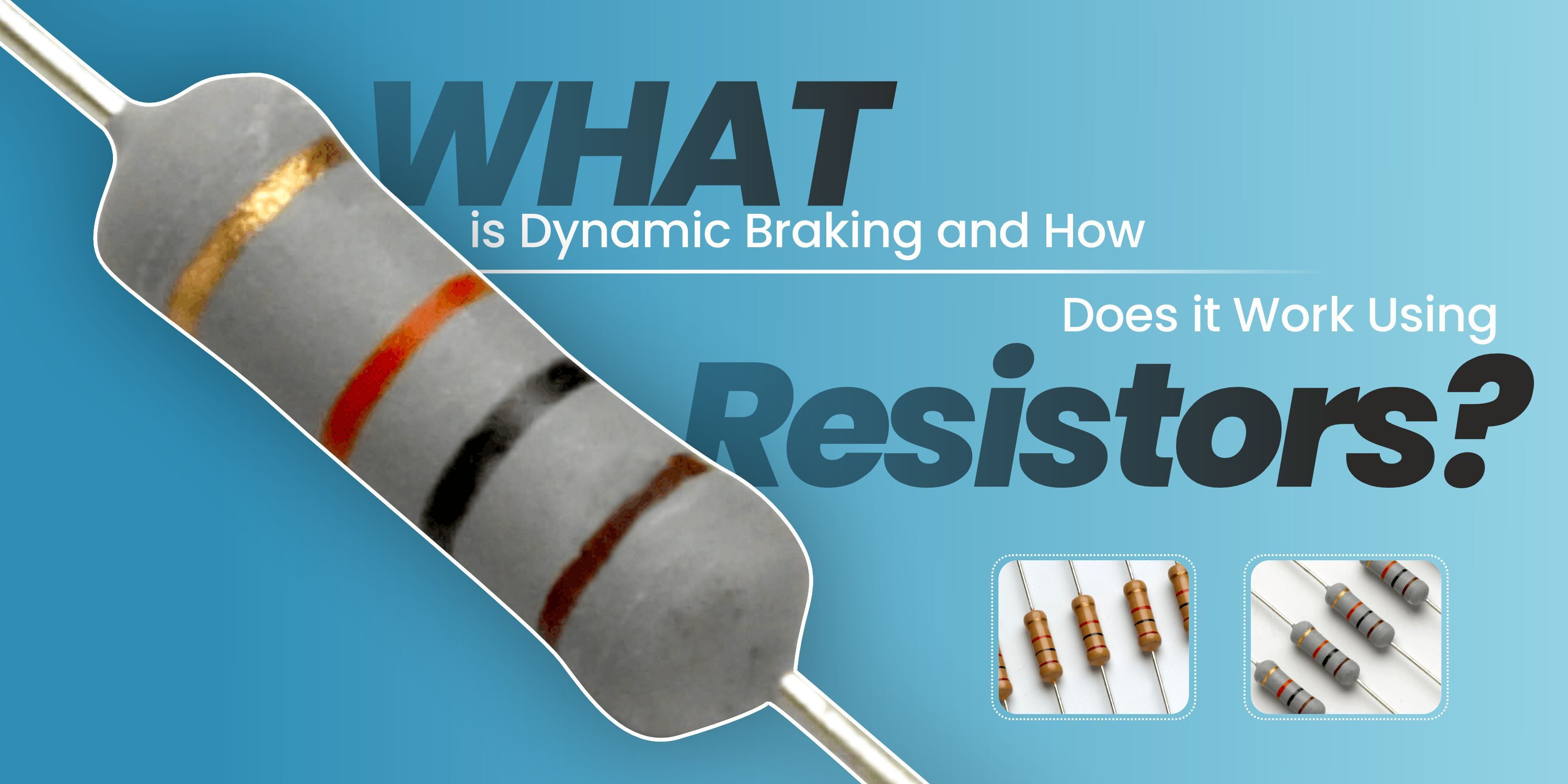
What is Dynamic Braking and How Does it Work Using Resistors?
Dynamic braking is a critical technology in the world of electric motors and drives, enhancing the safety, efficiency, and longevity of machines.
1. What is Dynamic Braking?
Dynamic braking is a method used to slow down or stop electric motors quickly and efficiently. It is commonly used in industrial applications, such as cranes, elevators, conveyors, and electric vehicles. Unlike mechanical brakes, which rely on friction to stop a motor, dynamic braking converts the kinetic energy of the moving motor into electrical energy, which is then dissipated as heat.
Why Use Dynamic Braking?
Dynamic braking offers several advantages over traditional braking systems:
- Faster Stopping: Provides quicker deceleration compared to mechanical brakes.
- Reduced Wear and Tear: Minimizes wear on mechanical components, such as brake pads and discs.
- Energy Efficiency: Some systems can recover and reuse the electrical energy generated during braking.
- Improved Safety: Ensures controlled deceleration, especially in heavy-duty applications.
2. How Does Dynamic Braking Work?
To understand how dynamic braking works, we need to look at the basic components involved:
- Electric Motor: The primary mover that requires braking.
- Drive System: Controls the motor’s operation and manages the braking process.
- Resistor Bank: The key component that dissipates the electrical energy generated during braking.
Step-by-Step Process of Dynamic Braking:
- Motor Operation: During normal operation, the electric motor drives a load, converting electrical energy into mechanical energy.
- Initiating Braking: When braking is required, the drive system disconnects the motor from the power source and switches it to a braking mode.
- Energy Conversion: The motor, still turning, acts as a generator. Its kinetic energy is converted into electrical energy.
- Dissipation via Resistors: The electrical energy generated is directed to a resistor bank, where it is dissipated as heat.
- Heat Management: The resistor bank is designed to handle the heat generated, preventing any damage to the system.
Dynamic Braking Using Resistors: The Role of Cermet Resistors
Resistors play a pivotal role in dynamic braking systems. When the motor switches to braking mode, the energy must be dissipated safely and quickly to avoid any damage. Cermet offers high-quality resistors that are designed specifically for dynamic braking applications.
Types of Resistors Used in Dynamic Braking:
- Aluminium Encased Braking Resistors: These are compact and have excellent heat dissipation capabilities, making them suitable for various applications.
- High Power Wirewound Resistors: These are designed to handle high power levels and are often used in heavy-duty braking systems.
- Steel Grid Resistors: These resistors can withstand extreme temperatures and are ideal for applications with high power requirements.
Why Choose Cermet Resistors for Dynamic Braking?
Cermet resistors are designed to offer:
- High Heat Dissipation: Efficiently manage and dissipate the electrical energy generated during braking.
- Durability: Constructed to withstand high temperatures and harsh industrial environments.
- Precision: Engineered to provide accurate resistance values, ensuring effective braking performance.
- Customizability: Available in various sizes and specifications to meet the specific needs of different applications.
3. Advantages of Dynamic Braking with Resistors
Dynamic braking using resistors offers numerous benefits over other braking methods:
A. Faster and Controlled Stopping
Dynamic braking provides a controlled deceleration of motors, which is essential in applications where safety is paramount. By converting kinetic energy to electrical energy and dissipating it as heat, dynamic braking allows for faster and smoother stops compared to mechanical brakes.
B. Enhanced Equipment Lifespan
Since dynamic braking does not rely on mechanical components like brake pads and discs, there is significantly less wear and tear on the equipment. This leads to reduced maintenance costs and extends the lifespan of the machinery.
C. Energy Efficiency
While dynamic braking primarily dissipates energy as heat, some advanced systems can recover a portion of this energy and feed it back into the power supply, increasing overall energy efficiency.
D. Reduced Maintenance and Downtime
Mechanical brakes require regular maintenance to replace worn-out components. Dynamic braking, however, involves fewer moving parts, leading to less frequent maintenance and reduced downtime.
E. High Reliability in Critical Applications
Dynamic braking is especially beneficial in critical applications such as elevators, cranes, and trains, where rapid and reliable stopping is crucial. Using high-quality resistors from Cermet ensures consistent performance and reliability.
4. Applications of Dynamic Braking
Dynamic braking is widely used across various industries, thanks to its versatility and efficiency. Here are some key applications:
- Cranes and Hoists: Dynamic braking ensures controlled and safe stops for heavy machinery like cranes and hoists, preventing accidents and damage to equipment.
- Elevators and Escalators: In buildings, dynamic braking helps manage the smooth and controlled movement of elevators and escalators, ensuring passenger safety and comfort.
- Industrial Machinery: In industries where heavy machinery operates at high speeds, dynamic braking ensures quick and safe stops. This is particularly important for conveyor belts, cranes, and hoists.
- Transportation: Dynamic braking is an essential component of electric and hybrid vehicles, enabling efficient braking and reducing wear on mechanical brake systems.
- Renewable Energy Systems: Wind turbines and solar trackers often use dynamic braking to safely slow down or stop operations during maintenance or emergency shutdowns.
5. How to Choose the Right Resistor for Dynamic Braking
Selecting the right resistor for dynamic braking is crucial to ensure efficient energy dissipation and reliable operation. Here are some key factors to consider:
A. Power Rating
Choose a resistor with a power rating that matches the requirements of your application. Cermet offers resistors with various power ratings to suit different needs.
B. Resistance Value
The resistance value determines how much electrical energy will be dissipated as heat. It is important to select a resistor with the correct resistance value to achieve optimal braking performance.
C. Thermal Management
Ensure that the resistor you choose can handle the heat generated during braking without damage. Cermet’s resistors are designed with excellent thermal management capabilities to ensure reliable performance.
D. Size and Mounting Options
Consider the size and mounting options of the resistor to ensure it fits within the available space in your application. Cermet offers resistors in a range of sizes and configurations to accommodate different installation requirements.
6. Conclusion
Dynamic braking is an essential technology for safely and efficiently stopping electric motors. By using resistors, such as those provided by Cermet, dynamic braking systems can effectively dissipate the electrical energy generated during braking, ensuring smooth and reliable operation. Whether you are working in industrial automation, transportation, or renewable energy, dynamic braking with Cermet resistors offers a reliable and efficient solution to your braking needs.
For more information on dynamic braking resistors and how Cermet can help optimise your braking system, visit our website: Cermet.

